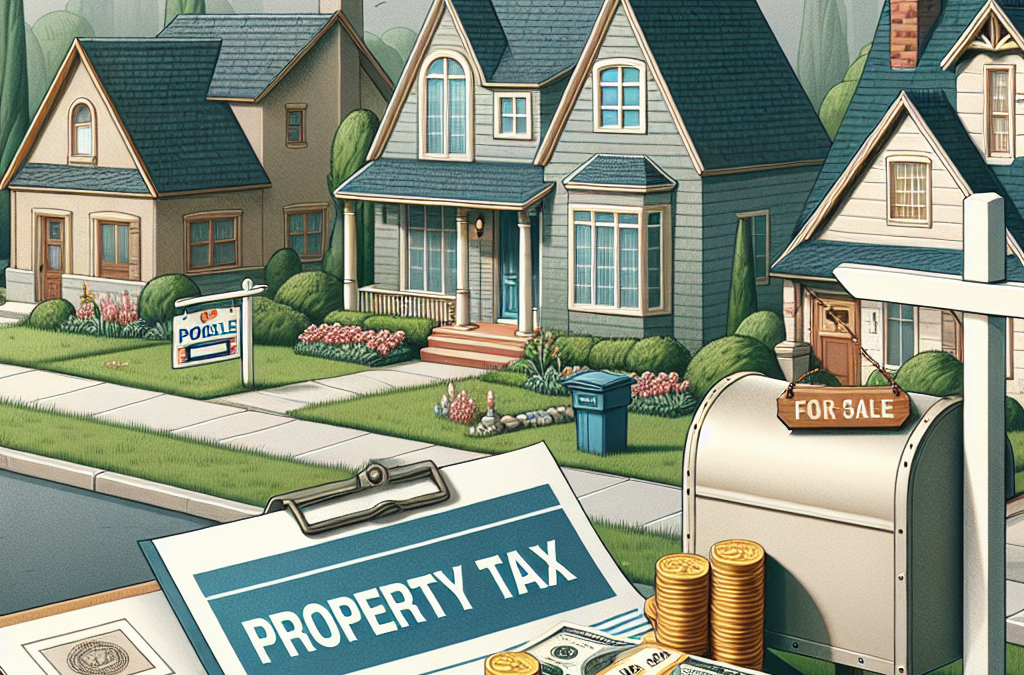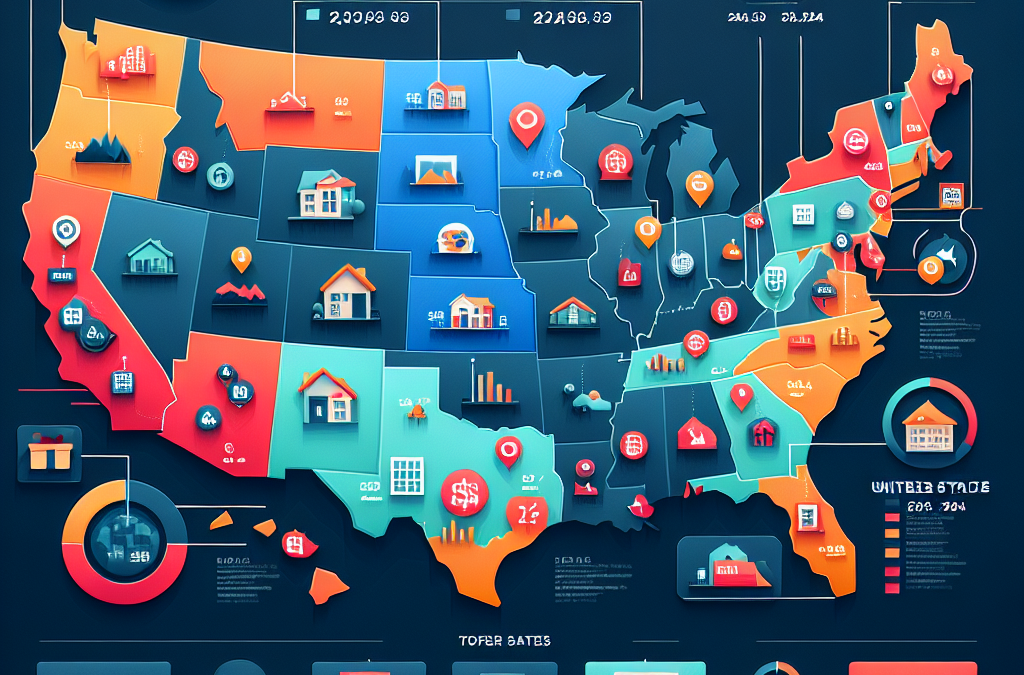
Real Estate
Property taxes are an essential source of revenue for state and local governments, funding schools, emergency services, and infrastructure. However, for Connecticut homeowners, these taxes are among the heaviest in the nation. According to a recent report, Connecticut ranks third in the United States for the highest property tax burden, trailing only behind New Hampshire and Illinois.
Why does Connecticut have such high property taxes, and how does this impact its residents? Let’s take a deeper dive into the factors contributing to this burden and what it means for homeowners and potential buyers in the state.
## Understanding Connecticut’s Property Tax Burden
### What Is Property Tax Burden?
The term “property tax burden” refers to the proportion of a homeowner’s income that goes toward paying property taxes. This burden can be particularly high in states that rely heavily on property taxes to fund public services.
In Connecticut, property taxes are not just high in absolute terms; they also account for a significant chunk of household income. According to the recent report, Connecticut residents pay an average of 5.39% of their income toward property taxes, making it one of the most expensive states for homeowners.
### How High Are Connecticut’s Property Taxes?
To put the numbers into perspective:
- The average effective property tax rate in Connecticut is 2.15%, well above the national average of 0.99%.
- Homeowners in the state shell out an average of $6,500 annually in property taxes, with some areas paying significantly more.
- Connecticut has consistently ranked in the top three for property tax burdens over the past several years.
Compared to neighboring states such as Massachusetts and Rhode Island, Connecticut’s property taxes stand out for their staggering cost.
## Why Are Connecticut’s Property Taxes So High?
Connecticut’s high property taxes are the result of several key factors. Understanding these reasons can help homeowners and prospective buyers make better financial decisions.
### 1. No County Government to Spread the Tax Burden
Unlike many other states, Connecticut does not have a county-level government overseeing public services. Instead, each city and town in Connecticut is responsible for funding its own schools, emergency services, and local infrastructure. This means municipalities rely heavily on property taxes to cover expenses.
### 2. High Cost of Public Services
Connecticut consistently ranks among the wealthiest states in the country, with a high median income. While this leads to excellent public services, it also increases the costs associated with maintaining infrastructure, funding education, and paying for essential services such as police and fire departments.
### 3. Declining Population and Shrinking Tax Base
Over the past decade, Connecticut has seen slow population growth and even population declines in some areas. As more residents move to lower-tax states, the number of taxpayers contributing to the system decreases. This forces municipalities to raise property tax rates to compensate for the lost revenue.
### 4. Heavily Funded Public Education System
Education is one of the biggest expenses that property taxes help fund. Connecticut has an extensive and well-regarded public school system, but schools require significant financial resources to maintain a high level of education.
According to the U.S. Census Bureau, Connecticut spends over $20,000 per student annually on education, one of the highest rates in the nation. These costs are paid primarily through property taxes, further increasing the burden on homeowners.
## How Connecticut’s Property Tax Burden Affects Homeowners
The high property tax burden in Connecticut has far-reaching implications for both current homeowners and prospective buyers.
### 1. Higher Homeownership Costs
For buyers considering purchasing a home in Connecticut, high property taxes can make homeownership significantly more expensive. A costly tax bill can impact affordability, making monthly mortgage payments higher than what potential homeowners might expect.
### 2. Impact on Housing Market
Connecticut’s real estate market is directly affected by property tax rates. Homes in high-tax areas may sell more slowly because prospective buyers factor property taxes into their overall cost of living.
This can sometimes lead to:
- Decreased home values in regions with extreme tax burdens.
- Slower housing market growth when compared to states with lower property tax rates.
- Challenges for retirees who may be on fixed incomes and struggle to afford increasing property tax payments.
### 3. Increased Cost of Living
In addition to housing costs, high property taxes contribute to Connecticut’s overall high cost of living. Residents may find that their disposable income is lower compared to those living in states with lower taxation.
## Potential Solutions and Alternatives
While high property taxes remain a reality for Connecticut residents, policymakers have discussed various strategies to alleviate the burden.
### 1. Statewide Property Tax Reform
Some experts suggest restructuring Connecticut’s tax system to rely less on property taxes. This could involve a higher reliance on sales tax or income tax to spread the burden more evenly. However, tax reform remains a complex and politically sensitive issue.
### 2. Regionalization of Services
Since Connecticut municipalities handle their own public services, regionalizing certain governmental functions—like school districts or emergency services—could help lower costs and, in turn, reduce property taxes.
### 3. Property Tax Relief Programs
Connecticut offers some tax relief programs, particularly for seniors and veterans. Expanding these programs could help ease the tax burden for those most affected by high property taxes.
## Final Thoughts
Connecticut’s ranking as the third-highest property tax burden in the country underscores the financial challenges faced by its homeowners. While beautiful landscapes, high-quality education, and strong public services make Connecticut an attractive place to live, the cost of homeownership is significantly impacted by property taxes.
Prospective buyers should factor property tax rates into their home purchase decisions, while policymakers continue to explore ways to balance state revenue needs with taxpayer affordability. Until significant reforms are enacted, Connecticut homeowners will continue to bear one of the heaviest property tax burdens in the nation.

Real Estate
# Best U.S. Real Estate Markets for Buyers and Sellers in 2024
The U.S. real estate market continues to shift in 2024, creating unique opportunities for both buyers and sellers. Some cities favor sellers with high demand and rising prices, while others provide buyers with better affordability and negotiation power.
In this article, we’ll explore the best real estate markets across the country, highlighting the top cities for homebuyers and those offering the best conditions for sellers.
## Understanding the 2024 Real Estate Market Trends
The housing market has undergone significant fluctuations over the past few years, influenced by factors such as inflation, interest rates, and changing buyer preferences. Here are some key trends impacting the market in 2024:
– Mortgage Rates: While interest rates remain higher than pandemic-era lows, they have stabilized compared to the spikes seen in 2022 and 2023.
– Inventory Levels: Some cities are experiencing housing shortages, which drive up home values, while others have increasing supply, leading to a more buyer-friendly market.
– Affordability Concerns: Rising home prices continue to challenge affordability in certain regions, while other areas offer comparatively lower home prices.
– Regional Demand Shifts: Migration patterns are affecting local real estate markets, with states like Florida and Texas seeing continued population growth.
Now, let’s dive into the best U.S. cities for real estate buyers and sellers in 2024.
## Best U.S. Markets for Homebuyers in 2024
For those looking to buy, certain cities are offering better affordability, higher inventory, and more room to negotiate deals. These markets are characterized by lower demand relative to supply, which benefits buyers by giving them more choices and competitive pricing.
### Top Cities for Buyers
According to recent market data, the following cities are among the best for homebuyers in 2024:
Austin, Texas: Home prices in Austin have cooled after rapid pandemic-era growth, making it an appealing market for buyers looking to secure a home at lower prices compared to recent years.
Las Vegas, Nevada: An increasing supply of homes has shifted market conditions, giving buyers more negotiating power.
San Antonio, Texas: San Antonio remains one of the more affordable metro areas in Texas, with prices stabilizing and more inventory becoming available.
Memphis, Tennessee: Memphis offers strong affordability compared to many larger U.S. cities, making it a prime location for first-time buyers.
Jacksonville, Florida: While Florida remains a desirable location, Jacksonville has more available homes and less competition, favoring buyers in 2024.
### Benefits of Buying in These Markets
– More Negotiation Leverage: Sellers in these markets are often more willing to negotiate on price and closing costs.
– Higher Inventory: Buyers have a greater selection of homes to choose from, reducing the risk of bidding wars.
– Better Affordability: These cities offer lower home prices compared to national averages and other major urban centers.
If you’re considering purchasing a home, these markets provide excellent opportunities to buy on favorable terms.
## Best U.S. Markets for Sellers in 2024
On the other side of the spectrum, some real estate markets continue to favor sellers due to high demand, low inventory, and rising home prices. In these areas, sellers can expect competitive offers, quicker sales, and strong returns.
### Top Cities for Sellers
The following cities rank among the best seller-friendly markets in the U.S. this year:
San Jose, California: With limited inventory and strong demand, San Jose remains a hot market, allowing sellers to secure top dollar for their properties.
San Francisco, California: Despite economic shifts, San Francisco’s housing market continues to see strong demand, making it advantageous for sellers.
Seattle, Washington: Seattle’s real estate market remains tight, leading to steady price increases and strong selling conditions.
Tampa, Florida: Population growth and a booming economy make Tampa a competitive market where sellers hold significant negotiating power.
Nashville, Tennessee: Nashville’s ongoing growth in employment and entertainment industries keeps housing demand high, benefiting sellers significantly.
### Advantages for Sellers in These Markets
– Faster Sales: Due to a competitive environment, homes in these cities receive strong interest and often sell quickly.
– Higher Sale Prices: Low inventory and high demand push home prices upward, maximizing seller profits.
– Multiple Offers: Many sellers in these locations are experiencing bidding wars, resulting in favorable sales conditions.
If you’re looking to sell your home in 2024, these markets provide excellent opportunities to achieve top dollar.
## How to Navigate the 2024 Real Estate Market
Whether you’re buying or selling, understanding the market dynamics is crucial to making the right decision. Here are some key strategies:
### Tips for Buyers
Get Pre-Approved: Secure mortgage pre-approval to strengthen your bargaining position.
Be Patient: In buyer-friendly markets, inventory is higher, so take your time finding the right home.
Negotiate Closing Costs: In many markets, sellers are willing to cover some or all of the closing costs.
### Tips for Sellers
Price Competitively: Even in a seller’s market, setting the right listing price can maximize interest.
Stage Your Home: A well-staged home can appeal to buyers and increase your final sale price.
Work with a Knowledgeable Agent: Partnering with an experienced real estate agent helps in marketing and negotiations.
## Final Thoughts
The real estate market in 2024 presents distinct advantages for both buyers and sellers, depending on location. If you’re looking to buy, cities like Austin, Las Vegas, and Jacksonville offer great opportunities with increased inventory and negotiable pricing. On the other hand, if you’re selling, cities like San Jose, Tampa, and Seattle remain hot markets with strong demand.
Understanding these market trends can help you make informed real estate decisions, whether you’re searching for your dream home or aiming to sell at the best price. Always stay updated on local market conditions and seek guidance from real estate professionals to maximize your opportunities.
Are you planning to buy or sell this year? Let us know your thoughts in the comments!

Real Estate
“`html
Top 10 Best U.S. Cities to Invest in Short-Term Rentals
Investing in short-term rentals through platforms like Airbnb and Vrbo continues to be a profitable strategy for real estate investors. Whether you’re looking for a vacation rental or a steady stream of passive income, choosing the right location is crucial. In 2025, several cities in the U.S. stand out as top markets for short-term rental investment.
According to new data from AirDNA, these cities offer the best combination of high occupancy rates, strong nightly rates, and growing traveler demand. Below, we’ll explore the top 10 U.S. cities to invest in short-term rentals in 2025.
1. Phoenix, Arizona
Phoenix has become one of the best markets for short-term rentals, thanks to its warm climate, steady tourism, and booming real estate market. With major events like spring training and a growing population, short-term rentals see consistent demand year-round.
Why Invest in Phoenix?
- High occupancy rates due to year-round sunshine and sporting events.
- Affordable property prices compared to other major U.S. cities.
- Increasing demand from both business and leisure travelers.
2. Nashville, Tennessee
Known for its vibrant music scene and cultural attractions, Nashville remains a hotspot for short-term rental investors. With tourism at an all-time high, demand for vacation rentals remains strong.
Why Invest in Nashville?
- Music and entertainment draw millions of tourists each year.
- Thriving short-term rental market despite regulatory challenges.
- Growing corporate presence increasing business travel demand.
3. Orlando, Florida
As the theme park capital of the world, Orlando consistently ranks as one of the most profitable cities for vacation rentals. With year-round tourism and family-friendly attractions, occupancy rates remain high.
Why Invest in Orlando?
- Consistently strong demand due to major attractions like Disney World and Universal Studios.
- Competitive average daily rates compared to other vacation destinations.
- Short-term rental-friendly policies in surrounding areas.
4. Austin, Texas
Austin’s reputation as the “Live Music Capital of the World” and its growing tech industry make it a great city for short-term rentals. With consistent events and festivals, occupancy rates remain high throughout the year.
Why Invest in Austin?
- Strong event-based tourism including SXSW and ACL Festival.
- Thriving tech industry bringing an influx of business visitors.
- Relaxed short-term rental regulations in some areas.
5. San Diego, California
San Diego’s perfect weather, stunning beaches, and strong vacation rental demand make it an excellent investment choice for Airbnb hosts.
Why Invest in San Diego?
- Year-round tourism driven by beaches, theme parks, and outdoor activities.
- High average daily rates due to luxury coastal properties.
- Consistent demand from international travelers.
6. Charleston, South Carolina
Charleston is a Southern gem known for its historic charm and beautiful waterfront. Visitors flock to its cobblestone streets and historical sites, making rentals highly desirable.
Why Invest in Charleston?
- Steady tourism growth thanks to its rich history and beach proximity.
- Rising nightly rates as the city’s popularity increases.
- Limited hotel supply allows short-term rentals to flourish.
7. Denver, Colorado
With a strong mix of adventure tourism and business travelers, Denver is a great place to invest in short-term rentals. Nearby ski resorts also drive guest demand.
Why Invest in Denver?
- Growing tech hub leading to increased business travel.
- Outdoor adventure tourism attracting year-round visitors.
- Competitive short-term rental rates with solid profitability.
8. Miami, Florida
Miami is one of the hottest short-term rental markets in the U.S., with its beaches, nightlife, and international appeal ensuring high occupancy rates.
Why Invest in Miami?
- Rising demand for vacation homes due to warm weather and entertainment.
- Luxury rental market allowing for premium nightly rates.
- International visitor appeal, especially from South America and Europe.
9. Gatlinburg, Tennessee
Gatlinburg, nestled in the Smoky Mountains, is a vacation rental hotspot due to its proximity to one of the most visited national parks in the U.S.
Why Invest in Gatlinburg?
- Tourism driven by Great Smoky Mountains National Park.
- Strong profitability on cabin-style accommodations.
- Limited hotel competition, allowing short-term rentals to thrive.
10. Myrtle Beach, South Carolina
Myrtle Beach remains a tourist favorite, making it an excellent place to invest in a vacation rental. Its famous boardwalk and golf courses bring in millions of visitors each year.
Why Invest in Myrtle Beach?
- Affordable real estate prices compared to other beach destinations.
- High seasonal demand during summer months.
- Growing vacation rental market as travelers seek alternatives to hotels.
Final Thoughts
Investing in short-term rentals can be highly profitable if you choose the right city. The best markets tend to have high demand, strong occupancy rates, and attractive property prices.
Whether you’re looking to invest in a bustling urban center like Nashville or a scenic retreat like Gatlinburg, these ten cities offer some of the best opportunities for Airbnb and Vrbo hosts in 2025.
Before purchasing a short-term rental property, always check local regulations, analyze potential profitability, and consider the costs of property management. With the right strategy, these cities can offer a lucrative investment for years to come.
“`

Real Estate
Homeowners’ Associations (HOAs) are known for implementing rules that maintain the value and appearance of neighborhoods. But can an HOA influence what you do inside your own home? Specifically, can they prohibit smoking? This question has sparked intense debate among homeowners spanning Florida and beyond. Let’s explore the legal, practical, and ethical aspects of this controversial issue.
Understanding the Authority of HOAs
Before delving into the smoking debate, it’s vital to understand how much authority an HOA possesses.
- The Role of an HOA: HOAs establish rules, typically through covenants, conditions, and restrictions (CC&Rs), to maintain community standards and ensure a harmonious living environment.
- Enforcing Rules: These rules can cover everything from lawn maintenance to pet ownership, but their scope is determined by the HOA’s governing documents and local or state laws.
Generally, HOAs have a lot of power, but they aren’t above the law. If an HOA tries to implement rules that overstep legal boundaries, those rules may be challenged by homeowners. Smoking bans, especially inside private homes, tread into murky legal territory.
Why Would an HOA Want to Ban Smoking?
Smoking bans in HOA-regulated communities are often rooted in concerns over health, safety, and property value.
Health and Safety Concerns
- Secondhand Smoke: Smoking inside a unit may allow tobacco smoke to travel between homes, potentially affecting neighboring residents.
- Fire Hazards: Cigarettes and cigars are common causes of residential fires, creating concerns for multi-unit buildings such as condominiums or townhouses.
Impact on Property Value
- Residual Odors: Smoke can infiltrate walls, carpets, and ventilation systems, leading to costly remediation that may deter potential buyers.
- Amenities and Community Attractiveness: A smoke-free neighborhood is often seen as cleaner and more appealing to families and non-smokers, increasing property value overall.
Given these reasons, some HOAs argue that smoking restrictions serve the greater community good. But does that give them the right to enforce bans within your private residence?
Can an HOA Legally Ban Smoking in Private Homes?
The legality of smoking bans within private residences largely depends on the state you live in and the wording of your HOA’s governing documents. Here are some key factors:
Reviewing HOA Governing Documents
HOAs derive their authority from the CC&Rs. If these documents explicitly ban smoking within homes or grant the HOA the ability to enforce such restrictions, then they may have legal standing to do so.
- Some HOAs include lifestyle clauses in their CC&Rs, allowing regulations that improve community quality of life. If a smoking ban is categorized under this, you may be bound by it.
- However, HOAs cannot retroactively impose new restrictions without a vote or amendment to the CC&Rs. Always review your HOA’s documents closely.
State and Local Laws
State laws can also factor into whether an HOA can enforce smoking bans. For example:
- Florida: In Florida, HOAs can generally regulate community property, but banning smoking inside private homes is less clear-cut. Case law in the Sunshine State on this matter is still developing, which often leaves enforcement in a legal gray area.
- California: Some local governments in California already allow multi-unit building HOAs to restrict smoking in private residences due to secondhand smoke concerns.
Homeowners who feel their rights are being infringed upon can challenge an HOA-imposed smoking ban through mediation, arbitration, or legal proceedings. Courts often weigh the rights of the individual homeowner against the broader interests of the HOA.
What Are Your Options if Faced With a Ban?
If your HOA is attempting to ban smoking inside your home, here are some ways you can respond:
- Check Your Governing Documents: Familiarize yourself with the CC&Rs to see if the rule is explicitly laid out or if the HOA has overreached its authority.
- Communicate With the HOA: Open a dialogue with your HOA board to find out their reasoning and possible compromises. Perhaps designating outdoor smoking areas could serve as a middle ground.
- Seek Legal Advice: If you believe the ban violates your rights as a homeowner, consult a real estate attorney for guidance.
- Join Forces With Neighbors: If other residents feel similarly, you can band together to challenge the rule through collective action or a vote to amend the CC&Rs.
- Follow the Rule or Move: If the ban is legally enforceable and no changes can be made, you may have to adjust to the new restriction or find a living arrangement more aligned with your preferences.
Balancing Individual Rights With Community Standards
The core issue of smoking bans inside private homes comes down to balancing individual property rights with community well-being. Whether you’re a smoker defending your right to use your property as you see fit or a non-smoker advocating for clean indoor air, the debate is complex.
Both sides have valid concerns:
- Smokers: Many argue that what happens inside the privacy of their own home should be their business as long as it doesn’t affect neighbors.
- Non-Smokers: Conversely, neighbors’ health and property values may be adversely affected if smoke travels between units or lingers in common areas.
Ultimately, the outcome depends on local laws, HOA governance, and the ability of all parties to find a compromise that considers everyone’s needs.
Conclusion
So, can your HOA ban smoking inside your own home? The answer is, it depends. Legal precedent, CC&Rs, and state laws will play a significant role in determining whether an HOA has the authority to enforce such a restriction.
If you’re facing this situation, educating yourself on your rights and communicating effectively with your HOA are critical first steps. While HOAs aim to create pleasant living environments, they must also respect the boundaries of what happens behind closed doors. As this issue gains attention, homeowners and HOAs across the country must navigate these debates with fairness and transparency.

Real Estate
2025 Commercial Real Estate Market Set for Remarkable U.S. Growth
The U.S. commercial real estate market is poised for significant growth in 2025, according to recent research from CBRE’s highly anticipated 2025 U.S. Investor Intentions Survey. This annual survey provides critical insights into the priorities, preferences, and strategies of commercial property investors, offering an essential glimpse into where the industry may be headed. With market conditions showing resilience and opportunity, real estate investors and stakeholders have plenty to be optimistic about as we approach 2025.
In this blog post, we’ll explore key highlights from the CBRE survey, discuss growth drivers, and shed light on the investment opportunities fueling excitement in the U.S. commercial market.
—
The State of U.S. Commercial Real Estate in 2025
As the U.S. economy stabilizes post-pandemic, **commercial real estate (CRE)** is emerging as a resilient and lucrative asset class, poised for expansion in 2025. CBRE’s latest data reveals a steadily increasing level of investor confidence. Here’s what investors need to know:
- Recovery-Fueled Confidence: Investors are signaling renewed trust in the market, largely driven by economic growth and recovery in key sectors like office spaces, industrial properties, and retail locations.
- Higher Allocation to CRE: Many institutional and private investors are planning to increase their allocation to CRE, reflecting its growing appeal due to stable returns and inflation hedging potential.
- Resurgence of Secondary Markets: Investors are increasingly looking beyond tier-one metropolitan hubs to explore opportunities in secondary and tertiary U.S. markets.
These insights underscore the optimism surrounding 2025, especially with the CRE sector’s strong track record of adapting and evolving during uncertain times.
—
Growth Drivers in the 2025 Commercial Real Estate Market
A variety of factors are converging to make 2025 a promising year for commercial real estate growth in the U.S. Understanding these growth drivers is essential for making informed investment decisions. Here are some of the leading catalysts:
1. Thrive of the Industrial Sector
The **industrial sector** continues to be a primary growth engine, owing to sustained demand for **e-commerce fulfillment centers**, **warehousing**, and **last-mile delivery facilities**. According to CBRE, the need for efficient supply chain logistics solutions shows no signs of slowing in the coming years.
2. The Rise of Technology-Enabled Spaces
CBRE’s survey highlights the increasing importance of **smart buildings** and technology integration in commercial spaces. Properties equipped with advanced tech—like energy-efficient systems, smart security measures, and integrated coworking designs—are commanding premium valuations. Their appeal to millennial and Gen Z tenants makes them a hot investment.
3. Evolving Office Space Dynamics
While remote work and hybrid work models reshaped the office space sector, there’s significant evidence that companies are now rethinking their **long-term real estate strategies**. Flex spaces and sustainable, optimized office designs are attracting corporate tenants looking to reinvest in physical workplaces that support collaboration and innovation.
4. Growth in the Sunbelt Region
Sunbelt cities—like Austin, Dallas, Nashville, and Tampa—are drawing considerable investor interest due to fast-growing populations, pro-business policies, and expanding workforces. These cities are dominating CRE conversations, especially in sectors like multifamily housing and tech-friendly office spaces.
—
Key Opportunities for CRE Investors in 2025
With multiple forces shaping the CRE market, the 2025 landscape is rich with opportunities for savvy investors. Let’s take a deeper dive into sectors and strategies expected to shine.
Industrial and Logistics Properties
Why It’s Hot: The sustained boom of e-commerce giants like Amazon and FedEx has made industrial real estate a **cornerstone of modern logistics operations**. Investments in strategically located industrial hubs are expected to yield substantial returns in 2025.
Multifamily Housing
Why It’s Hot: Housing shortages in both urban and suburban markets, compounded by rising mortgage rates, make **rental properties** one of the most in-demand asset types. Multifamily developments in both gateway and Sunbelt markets are prime candidates for strong ROI.
Retail Reinvention
Why It’s Hot: While traditional retail has undergone disruption, niches like **high-end experiential retail spaces** and **mixed-use developments** are thriving. Adaptive reuse of underperforming malls into community-driven spaces is breathing new life into this sector.
Alternative Asset Classes
Why It’s Hot: Many institutional and private investors are branching out into **alternative commercial assets** like data centers, healthcare facilities, and life science properties. These properties benefit from strong long-term demand trends, particularly as technology and healthcare industries expand rapidly.
—
Challenges to Watch Out for in 2025
Despite the impressive outlook, CRE investors must remain mindful of potential headwinds. Here are some challenges that could shape strategies in 2025:
- Rising Interest Rates: Borrowing costs remain a critical concern, as prolonged Federal Reserve rate hikes could impact deal feasibility and returns.
- Economic Uncertainty: While the economy is stabilizing, fears of a potential recession or macroeconomic slowdown continue to loom over CRE markets.
- Environmental Regulations: Investors face increasing pressure to implement **sustainable practices** amid tightening regulations and tenant demand for green-certified spaces.
Staying ahead of these challenges will require innovative solutions and a focus on high-growth, high-demand sectors.
—
How Investors Can Prepare for 2025
Given the dynamic nature of the market, **preparation** is key for success in 2025. Here are some practical steps investors can take:
- Leverage Technology: Investing in **data analytics tools** can help identify market gaps and analyze high-potential locations.
- Focus on Diversification: Spread investments across regions, sectors, and property types to mitigate risks.
- Partner with Experts: Collaborating with reliable real estate brokers and property managers ensures better deal structuring and operational efficiency.
- Stay Agile: The ability to pivot strategies based on market trends and unforeseen challenges is more important than ever.
By staying informed and leveraging research like CBRE’s survey, investors can maximize their opportunities in the evolving landscape of 2025.
—
Conclusion
The U.S. commercial real estate market is gearing up for a **remarkable year in 2025**, marked by optimism, innovation, and growth across multiple sectors. While challenges remain on the horizon, the opportunities far outweigh the risks for informed and agile investors. From thriving industrial properties to multifamily developments and technology-driven office spaces, the avenues for success are vast and varied.
Whether you’re a seasoned CRE professional or a first-time investor, now is the time to start laying the groundwork for your 2025 investments. By capitalizing on emerging trends and maintaining a forward-thinking mindset, you can position yourself to thrive in the transformative commercial real estate market of tomorrow.

Real Estate
As climate change continues to reshape landscapes and economies globally, its impact on real estate investments, particularly in the multifamily sector, has grown increasingly significant. Multifamily properties, known for generating stable returns, are not immune to climate-related risks. From intensifying storm activity to rising sea levels and wildfires, real estate investors must adopt proactive measures to protect their assets and assure long-term profitability. This is where **climate risk assessments** come into play, offering valuable insights into potential environmental threats and opportunities for smart asset management.
Incorporating climate risk assessments into the due diligence process can help multifamily real estate investors better understand, mitigate, and adapt to climate challenges while enhancing their portfolios’ resilience and overall performance. Let’s explore how climate risk assessments are transforming investment decisions in this crucial real estate sector.
Why Climate Risk Matters for Multifamily Real Estate Investments
Climate risk is no longer a vague or distant concept for real estate investors—it has become a **substantial financial consideration**. Multifamily properties are particularly vulnerable to climate-related disruptions due to their dependency on long-term tenant stability and operational reliability.
The key climate risks facing multifamily real estate include:
- Flooding: Properties located in flood zones or coastal areas are at higher risk of damages resulting from heavy rainfall, storm surges, or rising sea levels.
- Wildfires: Regions prone to wildfires can cause significant infrastructure damage and increase insurance premiums.
- Extreme Heat: Prolonged exposure to heatwaves can strain building systems (e.g., HVAC) and lead to higher energy costs or tenant complaints.
- Severe Storms: Hurricanes, tornadoes, and other extreme weather events can disrupt operations, destroy property, or displace tenants.
Understanding and assessing these risks is critical for preserving property values, ensuring tenant safety, and safeguarding revenue streams. Ultimately, addressing climate risks can help investors make more informed decisions about acquisition, renovations, and long-term management strategies.
The Role of Climate Risk Assessment in Real Estate Investments
A **climate risk assessment** involves analyzing potential threats to a property’s physical and financial health as a result of climate change. These assessments incorporate both historical data and forward-looking climate projections to provide a comprehensive picture of a property’s environmental vulnerabilities. When applied to multifamily real estate investments, they offer several substantial benefits:
1. Identifying Vulnerabilities
Climate risk assessments enable investors to pinpoint where multifamily properties are exposed to environmental hazards. By leveraging advanced data and mapping tools, investors can visualize risks like flood zones, wildfire-prone areas, or regions experiencing increasing heat stress. This allows them to evaluate the feasibility of investing in or upgrading a particular property.
2. Mitigating Financial Risks
Climate-related damages can result in costly repairs, business interruptions, and even lawsuits. By identifying risks beforehand, investors can implement preventive measures such as improved drainage systems, fire-resistant materials, or upgraded HVAC systems, reducing potential losses.
3. Enhancing Asset Resilience
Properties built or retrofitted to withstand climatic events are more likely to retain value and sustain occupancy rates, even in the face of adverse conditions. Climate risk assessments guide decisions about how to adapt properties to future risks, ensuring they are more resilient.
4. Attracting ESG-Conscious Investors
Environmental, Social, and Governance (ESG) considerations are increasingly influencing investment decisions. Multifamily properties that demonstrate resilience and sustainability appeal to ESG-conscious investors who prioritize long-term, responsible investing.
How to Integrate Climate Risk Assessments into the Investment Process
To enhance the profitability and durability of multifamily real estate portfolios, integrating a climate risk assessment into every stage of investment is crucial. Here’s how:
1. Leverage Advanced Technology
Technological tools such as Geographic Information Systems (GIS), predictive climate modeling, and risk assessment platforms are revolutionizing the way investors analyze properties. These tools provide **real-time data on potential hazards**, as well as long-term projections to quantify risk exposure.
Example tools include:
- CoStar Risk Analytics
- CLIMsystems climate impact modeling
- Four Twenty Seven’s climate risk data platform
2. Collaborate with Climate Experts
Working with specialized consultants in climate science and resilience design ensures a more robust evaluation of multifamily properties. Their expertise can guide investors in interpreting assessment data and implementing cost-effective adaptive solutions.
3. Prioritize Risk Disclosure
Transparency in climate risk management is becoming a standard practice among institutional investors. Property owners and managers who proactively disclose risks and mitigation plans are more likely to build trust with stakeholders while attracting socially conscious investment capital.
4. Incorporate Resilience into Portfolio Strategy
Use climate risk assessments as a tool to shape acquisition strategies. Focus on properties in less vulnerable areas or those that have already been climate-proofed. Retrofit existing properties with resilience measures to strengthen their competitive standing in the market.
Case Studies: Success Stories in Climate-Conscious Multifamily Investments
Several forward-thinking real estate firms have already embraced climate risk assessments to enhance their portfolios. A standout success story is the implementation of flood-resistant design features in low-lying multifamily properties in Miami. Retrofitting projects included elevating mechanical systems, installing flood barriers, and utilizing water-resistant materials.
Another example comes from California, where investors mitigated wildfire risks in multifamily developments by introducing fire-resistant landscaping, upgrading roofing materials, and implementing comprehensive emergency response plans. These strategies resulted in higher insurance cost reductions and reduced tenant turnover, translating to **long-term financial gains**.
The Investment Opportunity in Climate Resilience
By proactively addressing climate risks, multifamily real estate investors can position themselves as leaders in a rapidly evolving market. With tenants and stakeholders increasingly prioritizing sustainability and safety, resilience has become an indispensable factor in determining a property’s attractiveness.
Why climate resilience is a smart investment:
- Higher tenant retention: Tenants are more likely to stay in properties that feel safe and well-maintained during adverse weather conditions.
- Reduced operational expenses: Climate-proofed buildings are less likely to incur massive maintenance and repair costs after climate events.
- Increased valuation: Properties adapted to mitigate climate risks attract buyers willing to pay a premium for future-proof investments.
- Brand differentiation: Showcasing climate resilience efforts enhances reputation and opens doors to additional investment opportunities.
Looking Ahead: Future-Proofing Multifamily Assets
The multifamily real estate sector is poised to experience substantial change as governments, investors, and the public demand greater climate accountability. Incorporating climate risk assessments today is no longer optional but essential for savvy investors looking to maximize returns while minimizing vulnerabilities.
By thoroughly evaluating and adapting properties to face climate challenges, multifamily real estate owners and operators can turn risks into opportunities. **Climate risk assessments empower investors to make better-informed decisions, uphold financial stability, and demonstrate their commitment to environmental and tenant well-being.**
Whether acquiring new assets or managing an existing portfolio, staying ahead of climate risks guarantees not only smoother operations but also sustainable growth. In an industry where resilience translates into returns, taking proactive steps now ensures multifamily real estate investments remain a foundation of thriving communities for decades to come.






